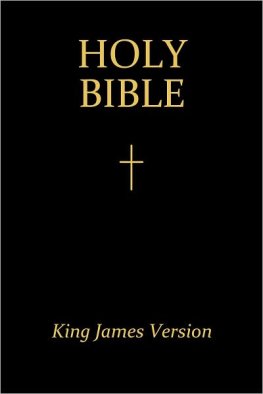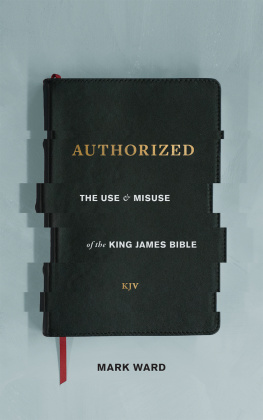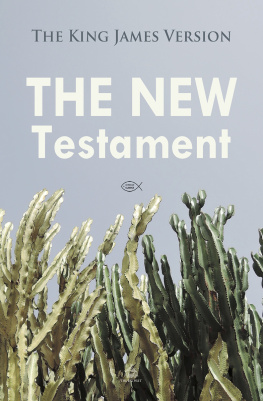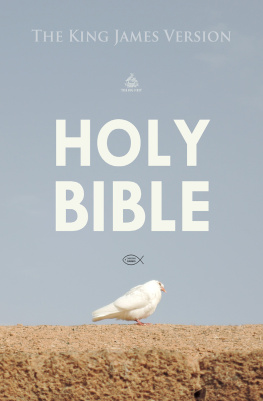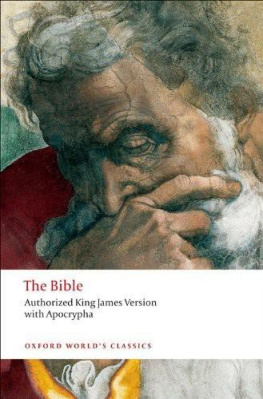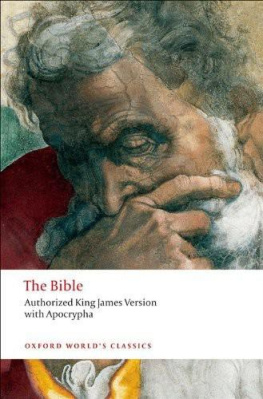Holy Bible, Authorized (King James) Version - NEW TESTAMENT
Here you can read online Holy Bible, Authorized (King James) Version - NEW TESTAMENT full text of the book (entire story) in english for free. Download pdf and epub, get meaning, cover and reviews about this ebook. genre: Religion. Description of the work, (preface) as well as reviews are available. Best literature library LitArk.com created for fans of good reading and offers a wide selection of genres:
Romance novel
Science fiction
Adventure
Detective
Science
History
Home and family
Prose
Art
Politics
Computer
Non-fiction
Religion
Business
Children
Humor
Choose a favorite category and find really read worthwhile books. Enjoy immersion in the world of imagination, feel the emotions of the characters or learn something new for yourself, make an fascinating discovery.

- Book:NEW TESTAMENT
- Author:
- Genre:
- Rating:3 / 5
- Favourites:Add to favourites
- Your mark:
- 60
- 1
- 2
- 3
- 4
- 5
NEW TESTAMENT: summary, description and annotation
We offer to read an annotation, description, summary or preface (depends on what the author of the book "NEW TESTAMENT" wrote himself). If you haven't found the necessary information about the book — write in the comments, we will try to find it.
Holy Bible, Authorized (King James) Version: author's other books
Who wrote NEW TESTAMENT? Find out the surname, the name of the author of the book and a list of all author's works by series.
NEW TESTAMENT — read online for free the complete book (whole text) full work
Below is the text of the book, divided by pages. System saving the place of the last page read, allows you to conveniently read the book "NEW TESTAMENT" online for free, without having to search again every time where you left off. Put a bookmark, and you can go to the page where you finished reading at any time.
Font size:
Interval:
Bookmark:
Book of Matthew
Although the first Gospel is anonymous, the early church fathers were unanimous in holding that Matthew, one of the 12 apostles, was its author. However, the results of modern critical studies -- in particular those that stress Matthew's alleged dependence on Mark for a substantial part of his Gospel -- have caused some Biblical scholars to abandon Matthean authorship. Why, they ask, would Matthew, an eyewitness to the events of our Lord's life, depend so heavily on Mark's account? The best answer seems to be that he agreed with it and wanted to show that the apostolic testimony to Christ was not divided.
Matthew, whose name means "gift of the Lord," was a tax collector who left his work to follow Jesus (9:9-13). In Mark and Luke he is called by his other name, Levi.
Date and Place of WritingSome have argued on the basis of its Jewish characteristics that Matthew's Gospel was written in the early church period, possibly the early part of a.d. 50, when the church was largely Jewish and the gospel was preached to Jews only (Ac 11:19). However, those who have concluded that both Matthew and Luke drew extensively from Mark's Gospel date it later -- after the Gospel of Mark had been in circulation for a period of time. See essay and chart, p. 1943. Accordingly, some feel that Matthew would have been written in the late 50s or in the 60s. Others, who assume that Mark was written between 65 and 70, place Matthew in the 70s or even later. However, there is insufficient evidence to be dogmatic about either view.
The Jewish nature of Matthew's Gospel may suggest that it was written in the Holy Land, though many think it may have originated in Syrian Antioch.
RecipientsSince his Gospel was written in Greek, Matthew's readers were obviously Greek-speaking. They also seem to have been Jews. Many elements point to Jewish readership: Matthew's concern with fulfillment of the OT (he has more quotations from and allusions to the OT than any other NT author); his tracing of Jesus' descent from Abraham (1:1-17); his lack of explanation of Jewish customs (especially in contrast to Mark); his use of Jewish terminology (e.g., "kingdom of heaven," where "heaven" reveals the Jewish reverential reluctance to use the name of God; see note on 3:2); his emphasis on Jesus' role as "Son of David" (1:1; 9:27; 12:23; 15:22; 20:30-31; 21:9,15; 22:41-45). This does not mean, however, that Matthew restricts his Gospel to Jews. He records the coming of the Magi (non-Jews) to worship the infant Jesus (2:1-12), as well as Jesus' statement that the "field is the world" (13:38). He also gives a full statement of the Great Commission (28:18-20). These passages show that, although Matthew's Gospel is Jewish, it has a universal outlook.
PurposeMatthew's main purpose is to prove to his Jewish readers that Jesus is their Messiah. He does this primarily by showing how Jesus in his life and ministry fulfilled the OT Scriptures. Although all the Gospel writers quote the OT, Matthew includes nine proof texts unique to his Gospel (1:22-23; 2:15; 2:17-18; 2:23; 4:14-16; 8:17; 12:17-21; 13:35; 27:9-10) to drive home his basic theme: Jesus is the fulfillment of the OT predictions of the Messiah. Matthew even finds the history of God's people in the OT recapitulated in some aspects of Jesus' life (see, e.g., his quotation of Hos 11:1 in 2:15). To accomplish his purpose Matthew also emphasizes Jesus' Davidic lineage (see Recipients, p. 1945).
StructureThe way the material is arranged reveals an artistic touch. The whole Gospel is woven around five great discourses: (1) chs. 5-7; (2) ch. 10; (3) ch. 13; (4) ch. 18; (5) chs. 24-25. That this is deliberate is clear from the refrain that concludes each discourse: "When Jesus had finished saying these things," or similar words (7:28; 11:1; 13:53; 19:1; 26:1). The narrative sections, in each case, appropriately lead up to the discourses. The Gospel has a fitting prologue (chs. 1-2) and a challenging epilogue (28:16-20).
The fivefold division may suggest that Matthew has modeled his book on the structure of the Pentateuch (the first five books of the OT). He may also be presenting the gospel as a new Torah and Jesus as a new and greater Moses.
OutlineThe Birth and Early Years of Jesus (chs. 1-2)
His Genealogy (1:1-17)
His Birth (1:18 -- 2:12)
His Sojourn in Egypt (2:13-23)
The Beginnings of Jesus' Ministry (3:1 -- 4:11)
His Forerunner (3:1-12)
His Baptism (3:13-17)
His Temptation (4:1-11)
Jesus' Ministry in Galilee (4:12 -- 14:12)
The Beginning of the Galilean Campaign (4:12-25)
The Sermon on the Mount (chs. 5-7)
A Collection of Miracles (chs. 8-9)
The Commissioning of the 12 Apostles (ch. 10)
Ministry throughout Galilee (chs. 11-12)
The Parables of the Kingdom (ch. 13)
Herod's Reaction to Jesus' Ministry (14:1-12)
Jesus' Withdrawals from Galilee (14:13 -- 17:20)
To the Eastern Shore of the Sea of Galilee (14:13 -- 15:20)
To Phoenicia (15:21-28)
To the Decapolis (15:29 -- 16:12)
To Caesarea Philippi (16:13 -- 17:20)
Jesus' Last Ministry in Galilee (17:22 -- 18:35)
Prediction of Jesus' Death (17:22-23)
Temple Tax (17:24-27)
Discourse on Life in the Kingdom (ch. 18)
Jesus' Ministry in Judea and Perea (chs. 19-20)
Teaching concerning Divorce (19:1-12)
Teaching concerning Little Children (19:13-15)
The Rich Young Man (19:16-30)
The Parable of the Workers in the Vineyard (20:1-16)
Prediction of Jesus' Death (20:17-19)
A Mother's Request (20:20-28)
Restoration of Sight at Jericho (20:29-34)
Passion Week (chs. 21-27)
The Entry of Jesus into Jerusalem as King (21:1-11)
The Cleansing of the Temple (21:12-17)
The Last Controversies with the Jewish Leaders (21:18 -- 23:39)
The Olivet Discourse (chs. 24-25)
The Anointing of Jesus' Feet (26:1-13)
The Arrest, Trials and Death of Jesus (26:14 -- 27:66)
The Resurrection (ch. 28)
The Earthquake and the Angel's Announcement (28:1-7)
Jesus' Encounter with the Women (28:8-10)
The Guards' Report and the Jewish Elders' Bribe (28:11-15)
The Great Commission (28:16-20)
Mat1:1 The book of the generation of Jesus Christ, the son of David, the son of Abraham.
Mat1:2 Abraham begat Isaac; and Isaac begat Jacob; and Jacob begat Judas and his brethren;
Mat1:3 And Judas begat Phares and Zara of Thamar; and Phares begat Esrom; and Esrom begat Aram;
Mat1:4 And Aram begat Aminadab; and Aminadab begat Naasson; and Naasson begat Salmon;
Mat1:5 And Salmon begat Booz of Rachab; and Booz begat Obed of Ruth; and Obed begat Jesse;
Mat1:6 And Jesse begat David the king; and David the king begat Solomon of her that had been the wife of Urias;
Mat1:7 And Solomon begat Roboam; and Roboam begat Abia; and Abia begat Asa;
Mat1:8 And Asa begat Josaphat; and Josaphat begat Joram; and Joram begat Ozias;
Mat1:9 And Ozias begat Joatham; and Joatham begat Achaz; and Achaz begat Ezekias;
Mat1:10 And Ezekias begat Manasses; and Manasses begat Amon; and Amon begat Josias;
Mat1:11 And Josias begat Jechonias and his brethren, about the time they were carried away to Babylon:
Mat1:12 And after they were brought to Babylon, Jechonias begat Salathiel; and Salathiel begat Zorobabel;
Mat1:13 And Zorobabel begat Abiud; and Abiud begat Eliakim; and Eliakim begat Azor;
Mat1:14 And Azor begat Sadoc; and Sadoc begat Achim; and Achim begat Eliud;
Mat1:15 And Eliud begat Eleazar; and Eleazar begat Matthan; and Matthan begat Jacob;
Mat1:16 And Jacob begat Joseph the husband of Mary, of whom was born Jesus, who is called Christ.
Mat1:17 So all the generations from Abraham to David are fourteen generations; and from David until the carrying away into Babylon are fourteen generations; and from the carrying away into Babylon unto Christ are fourteen generations.
Font size:
Interval:
Bookmark:
Similar books «NEW TESTAMENT»
Look at similar books to NEW TESTAMENT. We have selected literature similar in name and meaning in the hope of providing readers with more options to find new, interesting, not yet read works.
Discussion, reviews of the book NEW TESTAMENT and just readers' own opinions. Leave your comments, write what you think about the work, its meaning or the main characters. Specify what exactly you liked and what you didn't like, and why you think so.

